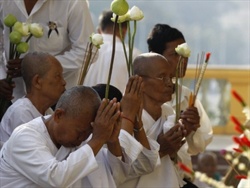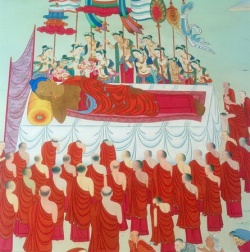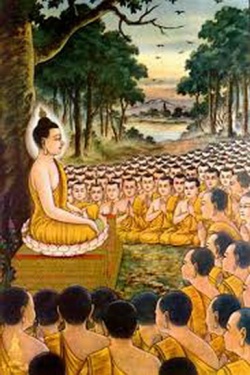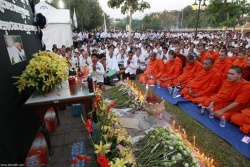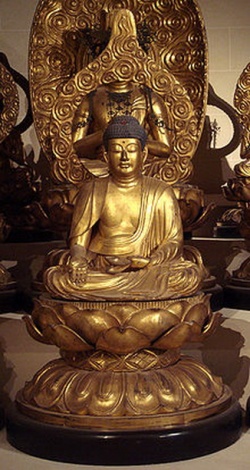Death in Cambodian Buddhist Culture
Author(s): Keo Mony
Reviewer(s): Jeniffer Huong
Date Authored: January 01, 2004
Date Last Reviewed: January 01, 2008
View Documentation
Death is grief as much to a Cambodian as to a Westerner. However, many Cambodians are Buddhists who do not view death as the end of one's life but rather as the end of a life cycle. It is a passage from one stage of the cycle to the next. In Buddhism, there is belief that all life/being evolves in a successive cycle of birth, sickness, old age, death and rebirth/reincarnation.
In Buddhist tradition, when death occurs it is very important to perform rituals in the correct and proper Buddhist tradition. Otherwise, it is believed, the deceased will not be able to move onto the next stage of the cycle, rebirth. Because of this, many Cambodians would be upset if they are not able to perform correct rituals for their loved ones. In one case, a $2 million lawsuit was filed in Georgia against a Funeral Home that cremated a body prematurely, depriving the living family from performing proper Buddhist funeral rituals.
(To read more about this case, see article Cremation Error Angers Buddhist Family at Law.com website.)
In Buddhist rituals, in life and at times of death, a monk plays a critical role. The monk performs blessing ceremonies at births, weddings and times of sickness. It is not unusual that a monk or monks are invited to recite sermon at the bedside of a seriously ill or comatose patient in order to chase away bad spirit and bless the sick to recover. The monk is at the bedside of the dying person in order to prepare him/her for the next life. It is very important, if it is at all possible, that a monk be at the place of death because that is where the soul exits the body but still remains present. It is believed that the soul is in a state of confusion and fright after exiting the body. The monk is needed to calm the soul.
In Cambodia, when a person dies, the care of the body is undertaken by family. The body would be brought home, washed, dressed, and placed into a coffin. The body is not to be dissected and organs are not to be removed because it is believed that would affect one's rebirth. The body is not embalmed. Traditionally, the body is kept in the house for seven days or longer before cremation. Today, it is common that the body is kept for only three days. Monks come to the home and recite sermon every evening by the body. On the third or the seventh day, a funeral procession is organized to carry the body to the temple for cremation. The crematorium is usually on or near the temple grounds. On some occasions such as the death of celebrities or high officials, a crematorium is built at some other place to accommodate the crowd.
A funeral procession consisting of an achar (priest) , Buddhist monks, members of the family, and other mourners accompany the coffin to the temple. The spouse and the children mourn their loved ones by shaving their heads and by wearing white clothing. White is the traditional color of mourning for the death, as opposed to black as is common to Westerners. However, in the United States, guests and extended family usually wear black. After cremation, the Buddhist ritual requires a funeral/remembrance ceremony to be held on the seventh or one-hundredth days after death. It can be held at the temple or the home, but usually is held at the temple.
It is believed that cremation allows the soul to part away from the body and to go to hell or heaven in order to wait for reincarnation. After cremation, the ashes (bones) are collected, cleaned and usually kept in a stupa in the temple compound. There it is believed that the deceased is close to Buddha and to the monks in whom the soul would be able to be reborn sooner. Some families keep the ashes at home. Other people have a piece of their beloved one's bone or tooth gilded as amulets, worn around their necks. This is done in love for the person, or in belief that the parting ancestor will protect them.
In the United States, Cambodians try to adhere to the funeral ritual as much as they are allowed. Most often, the body is kept for three days, although some families try to keep it up to the seventh day. How long the body is kept may depend on factors like the family's financial circumstances (the longer the body is kept, the more expensive it can be) or the lack of family living in the area where the death happens (when there are few or no family members around, the funeral practices may happen sooner; or, on the other hand, more time may be given for the arrival of family traveling from elsewhere). It is a long-held traditional practice and belief that the body not be dissected, nor that any parts be removed. Consultation about autopsy should happen with the living family members. Since the law in the United States does not allow the body to be brought home, some rituals have to be skipped. Many ritual practices are either held at the temple or at home while the body is held at the funeral home. Sometimes, monks will be invited to the funeral home to recite sermon by the body in the evening as required. Monks would always be invited to recite sermon right before the body is moved to the crematorium or burial site.
It is not uncommon that people would arrange the seventh and one hundredth day funeral ceremony for their parents, children or relatives who died in Cambodia.
The belief in afterlife and Karma has lead to a ceremony which Cambodians practice annually everywhere even in the United States. The ceremony known as Prachum Bend (gathering together to make offerings) is celebrated for fifteen days in September or October. Cambodians believe that some souls, because of bad karma, are not able to be reincarnated. Each year, for fifteen days, those souls are released to search for their living relatives, meditate and/or repent. People go to the temple and make offering of food to their ancestors and other trapped souls who have no living relatives. It is also an opportunity for the living to meditate and pray for their ancestor's soul to be repentant for bad karma that enables the ancestor's soul to reborn.
